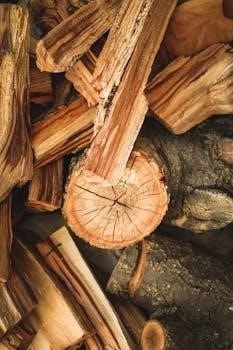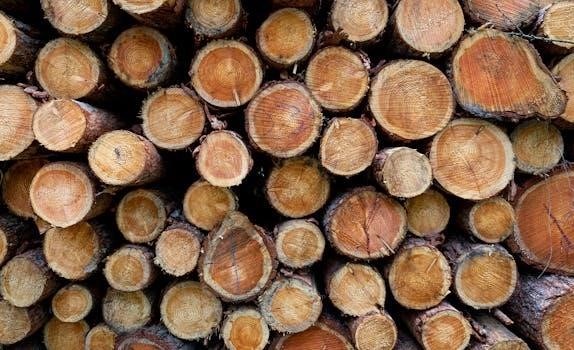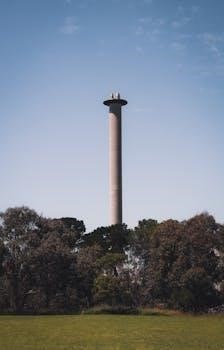Fireplace Construction Drawings PDF⁚ An Overview
This guide explores the essential aspects of constructing fireplaces using readily available PDF construction drawings. We’ll cover crucial components, chimney design, and essential safety regulations for a successful project.
Understanding fireplace construction begins with a thorough review of detailed drawings. These drawings, often available in PDF format, serve as a blueprint for builders and homeowners alike. They provide a comprehensive visual guide, outlining the precise dimensions, materials, and assembly steps required for a safe and efficient fireplace. These drawings are essential for ensuring structural integrity and compliance with local building codes, typically referencing standards like NFPA 211.
By utilizing CAD drawings and readily available resources, one can gain insight into firebox construction, chimney design, and hearth extension details. Whether undertaking a DIY project or collaborating with professionals, these drawings are invaluable tools for successful fireplace construction.
Types of Fireplace Construction
Fireplaces range from traditional masonry builds to prefabricated kits. Each type has unique construction methods, material requirements, and design considerations, impacting overall performance and aesthetic appeal.
Traditional Masonry Fireplaces
Traditional masonry fireplaces, crafted from brick or stone, offer timeless appeal and efficient heating. These structures require meticulous planning and precise execution, often guided by detailed construction drawings PDF. The firebox, constructed with fire-resistant materials, ensures safe containment of the fire. The chimney, essential for venting smoke and gases, demands careful design and construction to maintain proper draft.
The hearth, a non-combustible base extending into the room, protects flooring from sparks and embers. Blueprints showcase intricate details, including flue dimensions, damper placement, and firebox specifications. Architectural drawings and guides provide valuable insights for proper construction techniques. These resources outline safe clearances, framing requirements, and material specifications. A well-constructed masonry fireplace provides warmth, ambiance, and enduring value to any home, embodying a blend of functionality and craftsmanship.
Prefabricated Fireplace Kits
Prefabricated fireplace kits offer a convenient alternative to traditional masonry construction. These kits, designed for ease of installation, come with detailed instructions and construction drawings PDF. The components are pre-cut and ready to assemble, reducing construction time and labor costs. Prefabricated fireplaces often meet NFPA 211, ANSI Z 21.50, or UL127 standards, ensuring safety and compliance.
These kits typically include the firebox, chimney components, and decorative surrounds. Installation guides provide step-by-step instructions, including framing requirements and clearance specifications. CAD drawings and resources are readily available for precise measurements and customization options. Mason-Lite’s fully customizable fireplaces ship as pre-cut, complete kits, eliminating the need for field customization. Prefabricated fireplace kits offer a cost-effective and efficient solution for homeowners seeking the warmth and ambiance of a fireplace.

Key Components and Their Details
Understanding key components like the firebox, chimney, and hearth is crucial for safe fireplace construction. Detailed drawings and specifications ensure proper function, heat radiation, and structural integrity.
Firebox Construction Details
The firebox is the heart of any fireplace, containing the fire and radiating heat. Construction details are critical for durability and safety. Firebox walls, often made of firebrick, must withstand high temperatures. Proper detailing prevents cracking and ensures longevity. Do not grout solidly behind the firebox wall.
Detailed construction drawings specify firebrick dimensions, mortar types, and the overall firebox shape. These drawings also illustrate the firebox’s relationship to other components, like the smoke chamber and chimney. Adherence to these details guarantees efficient combustion and heat transfer. Consider using free CAD blocks and details in DWG or PDF formats.
Chimney Design and Construction
Chimney design is crucial for safely venting smoke and combustion gases. Drawings detail chimney height, flue size, and materials like brick, concrete, or metal. A well-designed chimney creates proper draft, ensuring efficient fireplace operation. The top of the chimney must be at least 2 feet higher than the peak of the roof.
Construction drawings specify flue liners and insulation requirements. These elements enhance safety and prevent heat loss. Details include connections to the firebox and the chimney’s termination point. Accessing free CAD drawings and blocks in DWG or PDF formats aids in visualizing and implementing these designs accurately. Proper chimney construction is vital for preventing fire hazards.
Hearth Extension Details
Hearth extension details are vital for safety, preventing sparks from reaching combustible flooring. Drawings specify dimensions and materials, such as brick, stone, or concrete. The extension must conform to safety regulations outlined in documents like NFPA 211. These drawings provide specifications for both interior and exterior fireplace setups.
Proper hearth extension ensures embers and hot materials don’t ignite nearby surfaces. Details include the extension’s thickness, width, and depth relative to the firebox opening. CAD drawings and PDF resources offer precise measurements. These details are critical in fireplace design and construction. The hearth must be constructed in accordance with safety standards.

Safety Regulations and Standards
Fireplace construction must adhere to strict safety regulations and standards. NFPA 211, ANSI Z 21.50, and UL127 are key compliance benchmarks. These standards ensure safe fireplace operation and installation.
NFPA 211 Compliance
NFPA 211, the Standard for Chimneys, Fireplaces, Vents, and Solid Fuel-Burning Appliances, is crucial for ensuring fireplace safety. Compliance with NFPA 211 minimizes fire hazards associated with improperly constructed or maintained fireplaces. This standard details requirements for chimney construction, clearances to combustibles, and proper installation of fireplace components. Meeting NFPA 211 standards is essential for preventing chimney fires and ensuring the safe operation of wood-burning appliances. The standard addresses various aspects, including chimney height, flue size, and the materials used in construction. Proper adherence to NFPA 211 guidelines protects occupants and property from potential fire risks linked to fireplace systems. Local building codes often incorporate NFPA 211, making compliance a legal requirement.
ANSI Z 21.50 and UL127 Standards
ANSI Z21.50 and UL127 are key safety standards for prefabricated fireplaces. ANSI Z21.50 covers vented gas fireplaces, ensuring safe operation and proper venting of combustion gases. UL127 focuses on factory-built fireplaces, evaluating their construction and performance under fire conditions. Meeting these standards demonstrates that a fireplace has undergone rigorous testing and complies with safety requirements. These standards address aspects like fire containment, structural integrity, and resistance to high temperatures. Compliance with ANSI Z21.50 and UL127 provides assurance that the fireplace is designed to minimize fire risks. Manufacturers often seek certification to these standards to demonstrate the safety and reliability of their products. Adhering to these standards is crucial for protecting homes and occupants from potential hazards.

Energy Efficiency Considerations
Energy efficiency in fireplaces involves exterior combustion air supply and damper flap recommendations. These features help minimize heat loss and improve overall heating performance, ensuring a more sustainable and cost-effective fireplace.
Exterior Combustion Air Supply
An exterior combustion air supply is vital for fireplace energy efficiency. It draws air from outside, preventing the depletion of heated indoor air for combustion. This reduces drafts and maintains a more consistent room temperature, minimizing energy waste. Supplying combustion air from outside improves fireplace performance and overall home energy efficiency.
Proper detailing and construction are crucial for optimal performance. By incorporating an exterior air supply, fireplaces can become more energy-efficient supplemental heating units. This feature helps to maintain the structural integrity of the fireplace while enhancing its ability to provide warmth without compromising energy conservation. This will maintain comfortable environment.
Damper Flap Recommendations
A damper flap is crucial for regulating airflow in a fireplace. It should be properly fitted and functional to prevent heat loss when the fireplace is not in use. A well-sealed damper minimizes drafts and improves energy efficiency.
For optimal performance, consider using a top-sealing damper, which provides a tighter seal compared to traditional throat dampers. Regular inspection and maintenance of the damper flap are essential to ensure it operates effectively; Damper flaps will reduce energy consumption. If the damper flap is not working properly, it can significantly increase heating costs.

CAD Drawings and Resources
Discover free CAD blocks and details in DWG and PDF formats for fireplace construction. Find resources to aid in designing and building your fireplace project effectively.
Free CAD Blocks and Details in DWG and PDF
Access a wide range of free CAD drawings, CAD blocks, and AutoCAD details for masonry fireplaces in both DWG and PDF formats. These resources are designed for use with AutoCAD and other 2D and 3D design software, simplifying the planning and construction process.
By downloading and utilizing ARCAT CAD content, users agree to the associated license agreement. Explore various options, including masonry fireplace details, framing clearances, and installation guides, all available for download. These digital resources offer updated drawings for efficient fireplace design.
Find detailed construction studies planning grids and technical notes covering residential fireplaces. These resources include information on components, design, dimensions, and energy efficiency considerations. Enhance your project with free access to essential CAD details.
Where to Find Fireplace Construction Drawings PDF
Discover resources for obtaining fireplace construction drawings in PDF format. Numerous platforms offer these essential documents, including online libraries and manufacturer websites. Look for sites providing architectural working drawings and guides for traditional fireplaces.
Explore options from companies like Mason-Lite, which offer customizable fireplace drawings meeting NFPA 211, ANSI Z 21.50, or UL127 standards. ARCAT provides CAD drawings and blocks for download in PDF format.
Search for technical notes and details covering various aspects of fireplace construction, including components, design, and dimensions. Check for free PDF guides detailing chimney construction and fireplace design considerations. Accessing these resources ensures accurate and safe fireplace construction.

